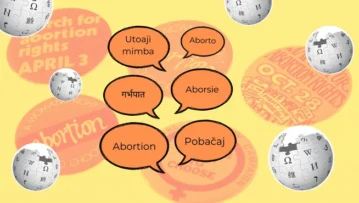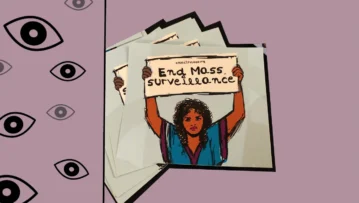This post was written by Nandini Oza for Whose Knowledge?
The Covid-19 Pandemic has brought forth questions around lifestyle and consumption levels, developmental issues, large projects with damaging ecological footprints, concerns regarding who benefits through big projects and who pays the price, sustainable and equitable development and related issues like never before. India has been having this debate around these issues for a long time now and it has a long history against large developmental projects, particularly against large dams with severe ecological impacts and large-scale displacement of people. The anti-large dam struggles in India and the world are important as these movements have also been able to retain the argument that development cannot merely be seen in the limited context of fossil fuel-based power generation, carbon footprints and climate change. But it is important to examine development in the context of the overall impact of increased power generation and consumption would have on the global environment, even if it is based on non-fossil fuel based energy production. And that it is important to determine priorities, focus on sustainable development, which is also equitable. It is in this larger context that it would be important to place the anti-large dam struggles in India.
The first anti-dam struggle in India and possibly even the world, was against the Mulshi dam, built at the confluence of Mula and Nila Rivers in western Maharashtra near Pune, a hundred years ago. Subsequently, there have been successful anti-dam struggles that have stalled big dam projects in the country. One of the most well-known is the campaign against the Silent Valley Project that was planned on the River Kuntipouza in Kerala, Southern India, that was to submerge prime forest lands. The anti-dam struggle against the Koel Karo Project in Jharkhand has also been successful in stalling a large-dam project for over 35 years now. And then, the powerful struggle against a large-dam based project named the Sardar Sarovar Project (SSP) on the River Narmada in Western India is considered to be one of the most important struggles post India’s independence. It is because of this powerful struggle called the Narmada Bachao Andolan (NBA) that the World Bank had to withdraw from a project it was funding. In fact, when over 250 organisations across the world called for a moratorium on funding of big dams by the World Bank, it was called the Manibeli Declaration after the village Manibeli, once the nerve center of the NBA.

What is significant about the NBA is that it was successful in delaying the completion of the dam wall for nearly two decades and has ensured some rehabilitation of those displaced by the dam. The NBA has also been successful in raising larger issues around the very development paradigm that big dams represent. In this process, the struggle in the Narmada valley and other dams across India have been successful to a great extent in questioning the popular discourse that large dams are temples of modern India and that dams are a green source of energy generation.
Importantly, such movements like the NBA have helped in the recognition of the people’s right to question “Development”, in the acceptance of people’s right to information and their right to participation in policy decisions and implementation. These struggles against development projects with large ecological footprints have also forced development planners to explore sustainable and equitable alternatives to water and energy production and supply. People’s movements like the NBA have helped in highlighting the threat developmental projects pose to indigenous communities and to the traditional knowledge of the resource dependent communities living on the banks of rivers, in forests and practicing agriculture and related natural resource dependent occupations.
What is significant about these struggles around developmental projects is that in many of these, women have played an extraordinary role and have often led the movement from the forefront.✰ However, women’s roles in these struggles that have raised very important issues concerning human rights, environmental impacts of such projects and the need for sustainable development, have gone generally unnoticed.

Some of the reasons why the role of women in these struggles have gone unnoticed is because development projects are considered necessary for the economic advancement/GDP growth and any opposition to it is often termed anti-development and even anti- national! While other forms of displacements like those due to wars, conflicts, natural calamities, etc., are considered tragedies and the people impacted have by and large state and civil society sympathy, the displacement of people by developmental projects is considered in national interest, economic interest and inevitable. The people displaced by such projects are expected to sacrifice for larger good willingly and their grievances are often not heard. In fact, when the women affected by the construction of SSP colony, known as Kevadia colony, now a tourism hotspot with the world’s tallest statue, organised themselves and questioned the project, they were called names and faced unprecedented repression at the hands of the State. This has been very well explained in her interview by Kapilaben Tadvi, a senior scheduled tribe leader of the NBA. Kapilaben says,
I have been thrashed number of times by the police. Wherever we went we were called witches! ‘The witches from 6 villages have come’, they would say and …we are caught without reason, even if we went to the market just like that, the police would be after us…lands are snatched away from these 6 villages, and it is not only that the people of 6 villages are harassed; but in this way, …the government harasses the people of all the 19 villages that are falling in the submergence (of the SSP dam)…
For full interview see: Kapilaben Tadvi – Oral History Narmada

Similarly, struggles of women against patriarchy often find substantial civil society and state support and progressive states even enact forward looking laws in support of women. But when it comes to development induced forcible displacement, even the best of rehabilitation policies and laws ignore the rights of women and their special requirements on displacement.

For example, women are particularly dependent on common property resources like the rivers, forests, grazing lands, etc., and when they lose all of these to the developmental project, there is no provision to provide the same in the resettlement sites after displacement. All of these make displaced women economically very vulnerable. A senior leader of the NBA belonging to scheduled tribe, Pervi says the following about the loss of forests and river due to the SSP,
The Government thought, ‘These useless monkeys! We will hit them and make them run away and we will fill the dam with water.’ But we fought for our rights in the movement and so, some people have got some land while others like us are left out. Our house and our cattle are also left out and we are unable to find land… We have these forested hills and we have wood and we have grazing lands for our cows and goats … Even if this land is submerged, we can survive by gathering and eating tubers and vegetables from the forest…The forest is our father and the river our mother. That is how we survive in the forests…And yet, the Government is not taking any cognizance of us!
For full interview see: Pervi – Oral History Narmada

Women also suffer more than men both socially and culturally on account of forced and involuntary displacement through developmental projects as they have to get used to areas where the language, communities, culture, traditions, economy, are different and totally unfamiliar in the rehabilitation sites. The host communities see the displaced people as outsiders and there is always some tension between the old and the new settlers. Women in particular fall victim to caste, class, ethnic, religious discrimination in the new areas where rehabilitation sites are located often hundreds of kilometers from their ancestral homes. Ushaben Tadvi, who belongs to a scheduled tribe and has been displaced due to the SSP, explains how the mobility of women has gone down after displacement to an extent that she finds it difficult to visit her family left behind as her resettlement site is far away from her ancestral home. She says,
Here (in resettlement site), only if we have 300 rupees, 400 rupees, we can go to our maternal home. These days, it is not possible to go to my maternal home for 2-3 years. Is there any money? Only if there is money it is possible to go, isn’t it? Whereas there (from our own village), we visited our maternal home every 2-3-5 days. We went walking also. What can we do after coming here (to the rehabilitation site)? Does not one wish to go home? Where one has grown up from childhood? We have been brought up there, don’t we want to meet brother, sister-in-law, mother, father? Now, only if we have 400- 500 rupees that it is possible to go to our maternal home. I went recently after 3 years and that too when someone died…From our old village it was possible to just walk down. There is a lot of difficulty, sister, but what do we do? We have sorrow upon us but who do we tell? Why has government come up with this? It would have been good if we were allowed to live in our old village. Why has the dam been built? It would have been good had the dam not been built.
For full interview see: Ushaben Tadvi – Oral History Narmada

It is for all these reasons and much more that women have been fighting against forcible displacement due to “Developmental Projects”, right from the time of the building of the Mulshi dam a 100 years ago in India. The reference of women having even been jailed in this struggle which is celebrating its 100th year this year, can be found in a well-documented book by author and historian Rajendra Vohra, translated excerpts of which are shared here: History less known: Mulshi dam Satyagraha and Women’s Participation (nandinikoza.blogspot.com)




In the case of the NBA, as an activist of the movement for twelve years, I felt that although the struggle in the Narmada valley has drawn widespread attention, much of the media reportage and documentation have focused either on the issues, major events or the few prominent faces of the movement. Even though the NBA has been a mass movement, drawing its strength from the power of the collective, the role, the contribution and the vision of local leaders, activists and common people who have formed the backbone of the struggle has hardly been recognized, understood or documented. More importantly, although women from outside and those from the affected areas have played a leading role in the struggle, very little is known about them except of course in the case of a few known faces. It was with this in mind, I felt it important to record the oral histories of the Narmada struggle around the SSP and have recorded detailed interviews of eighty senior members of the movement with 400 hours in digital recordings. Some of these interviews, including those of women belonging to scheduled tribes and natural resource dependent communities have been brought out through a website: Oral History Narmada – Oral Histories of the Narmada Struggle . And a book in Marathi, which is the oral history of two senior Adivasi (belonging to scheduled tribe) leaders of the movement has also been published.

This work is so that the traditional knowledge of the displaced communities of the Narmada valley severely impacted by the dam is archived for future reference. And also so that the role and extraordinary contribution of common people in the movement, including women has a legitimate place in the development and environment history and in the history of the Narmada Bachao Andolan in particular.
This post was written by Nandini Oza for Whose Knowledge?




